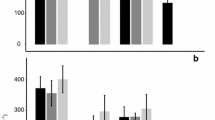Abstract
Hover-feeding glossophagine bats provide, in addition to the hummingbirds, a second vertebrate model for the analysis of hovering flight based on metabolic measurement and aerodynamic theory. In this study, the power input of hovering Glossophaga soricina bats (11.9 g) was measured by standard respirometry and fast-response (<0.2 s) oxygen analysis. Bats needed 5–7 s after a rest-to-flight transition to return to a respiratory steady state. Therefore, only hovering events preceeded by a 7-s flight interval were evaluated. V˙O2 during hovering fluctuated with a frequency of 3–5 Hz, which corresponded in frequency to the licking movement of the tongue. During hovering, bats often may have hypoventilated as indicated by reduced V˙O2 and a respiratory exchange ratio (RER) well below the steady-state value of 1. Steady-state oxygen consumption (and derived power input) during hovering was estimated to be 27 (25–29) ml O2 g−1 h−1 (158 W kg−1 or 1.88 W) in the 11.9-g bats as indicated by three independent findings: (1) V˙O2 was 26 ml O2 g−1 h−1 after 6.5 s of hovering, (2) the mean RER during single hovering events was at its steady-state level of 1 only at oxygen uptake rates of 25–29 ml g−1 h−1, and (3) when the oxygen potentially released from estimated oxygen stores was added to the measured oxygen uptake, the upper limit for oxygen consumption during hovering was found to be 29 ml O2 g−1 h−1. Hovering power input was about 1.2 times the value of minimum flight power input (Winter and von Helversen 1998) and thus well below the 1.7–2.6 difference in power output postulated by aerodynamic theory (Norberg et al. 1993). Mass specific power input was 40% less than in hummingbirds. Thus, within the possible modes of hovering flight, Glossophaga bats seem to operate at the high-efficiency end of the spectrum.
Similar content being viewed by others
Author information
Authors and Affiliations
Additional information
Accepted: 28 April 1998
Rights and permissions
About this article
Cite this article
Winter, Y. Energetic cost of hovering flight in a nectar-feeding bat measured with fast-response respirometry. J Comp Physiol B 168, 434–444 (1998). https://doi.org/10.1007/s003600050163
Issue Date:
DOI: https://doi.org/10.1007/s003600050163




